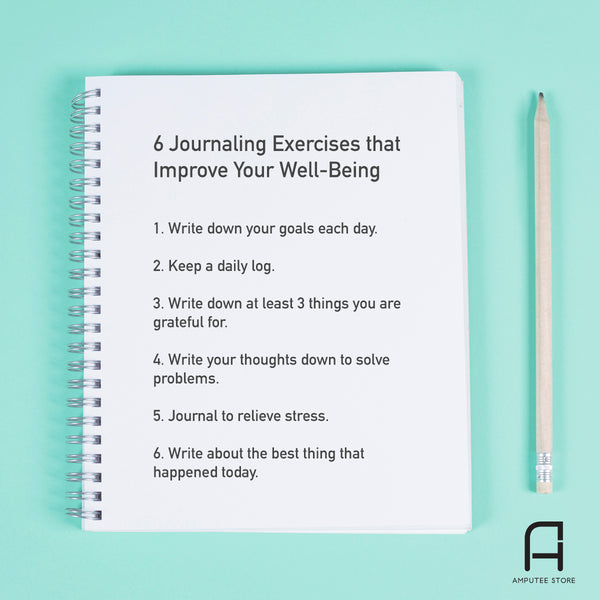6 Journaling Exercises that Improve Your Well-Being
These days, a conversation about health and overall well-being isn’t complete without talking about emotional and mental well-being. And one of the ways that both aspects of health can be ensured is in taking the time to put pen to paper and journal.

Journaling isn’t a foreign concept to me. I have noticed that whenever my wife and I argue, I know that I will find her writing a fury of feelings in her journal in the aftermath. As for me, journaling wasn’t always an everyday staple, but more of a once-a-year event. I only write in my journal every January 1 to write down all my goals and ideas and sift through the past year’s experiences. But what was unique about my practice was that I didn’t keep my once-a-year entry in a notebook; I would mail the entry to myself and re-read it before writing the next year’s goals.
Today, journaling is just as much a part of my everyday life as drinking a cup of coffee. I have felt the benefits of this seemingly tedious task, and I intend to keep this practice. I have noticed that regularly writing in my journal always leads to fresh, new insights and ideas that have transformed my life as well as my career.
Numerous studies support the benefits of journaling. Psychologists almost always recommend this practice to their patients as it lowers depression and anxiety. These findings are supported by a recent study conducted by the University of Arizona, which concluded that journaling helps improve a person’s health. It’s also said that the practice helps strengthen immune cells called T-lymphocytes.
But the effectivity of this practice depends on what you write and how you write. While others do best with a hardbound journal, others—like myself—are more consistent by using note-taking apps such as Evernote, Zoho Notes, and, my personal favorite, OneNote.
The benefits that I have seen in my own life are more than enough reason for me to recommend this practice to my patients as well as to you, my readers. So today, I will share with you some of my favorite journaling ideas so you can get your personal journal practice started.
1. Write down your goals each day.
My favorite format is writing down my goals each day. This is a crucial part of my morning routine, and it’s something that I have done daily over the past five years.
My morning routine goes like this: wake up, grab my journal, and re-write my goals for the day. It’s that simple.
One of the reasons why this format works is because writing down my goals every day reinforces my priorities. It reminds me of the things that matter most in my life at any given moment. Furthermore, this method helps you further refine your goals. The more you write, the more you notice that some become more specific while others are forgotten.
Second, writing your goals every day helps you achieve what you want in life. Writing your goals every day sends a message to your brain to take action until they become a reality.
If you want to get started on this method, here are some steps that you can incorporate in your morning routine:
• As soon as you wake up in the morning, open to a fresh page in your notebook and write your top 10 goals.
• Repeat the same process the next day and the day after that. Write down 10-15 goals without looking at the previous day’s entry. This is important because it helps you see which goals are important to you and which ones are not.
• Repeat for at least 30 days. You’ll notice that your goals are more precise and refined. They can also evolve or change altogether. Don’t worry if a goal falls to the wayside. This only shows that a specific goal wasn’t important to you. Simply put, this method allows you to hone in on what you want out of life. And don’t we all want clarity?
2. Daily log
The daily log is your running personal history. This can include what you did, ate, saw, and who you spoke with. It may sound mundane, but the best part of this format is that you have a hand-written record of your day-to-day life, which can come in handy later on when you need to remember something.
If you want to get started on this journaling format, here’s what you need to do:
• Get a journal small enough to bring with you every day.
• As the day unfolds and events happen, write them down in your notebook.
• Don’t limit yourself! You are not limited to the written word. If you want, you can also sketch, write bulleted lists, or write detailed notes. It’s essential that you know which one works for you since you need to do this process day in and day out.
3. Write down at least three things that you are grateful for
Another personal favorite, this method allows me to focus on the good things. I prefer writing my gratitude list in the morning as this enables positivity to reverberate throughout the day.
The main reason behind this method’s effectivity is because it’s virtually impossible to feel stressed and grateful at the same time. Whenever I find myself stressed and overwhelmed, I turn to my journal and write down the things for which I am grateful.
Here is my own short gratitude list:
1. Spending more time with my family and my newborn.
2. Doing work that helps people improve their lives and achieve their goals.
3. The hot coffee I’m sipping as I write this.
Make this a daily habit, and you’re sure to feel a domino effect of optimism with which you can approach any situation throughout the day.
To put this idea to action, consider incorporating the following into your routine:
• Crack open your journal or planner. It doesn’t matter if you choose to do this in the morning or evening. What matters is you set aside some time during the day to reflect on the good things in your life.
• Write down three things you’re grateful for.
• If you already keep a planner or a to-do list, you can also write your gratitude list there. This way, you can look at your list throughout the day as you check tasks off your to-do list. I assure you that this method helps you keep things in perspective as you work to complete the day’s tasks.
4. Journaling to solve problems.
If you’re having a hard time making a decision, then journaling can help you get unstuck. Whether you’re wondering if you should move to another city or figuring out if you should quit your job, writing down your thoughts can help you sort through the noise in your mind.
Many can attest to the practice’s problem-solving magic. This is because writing down your issues and problems can help you see that they’re not as daunting as they seem.
If you want to try this journaling method, here’s how you can get started:
• Whenever you’re faced with a challenge, open your journal and write down the problem as a question at the top of the page. For example: “I’ve been offered a job with great pay. However, the new position will take up so much time from my family. Should I accept it?”
• Next, write a list of potential solutions. You can also do some freewriting to dump all your thoughts and feelings about the issue. Then you can formulate possible solutions or a Pros and Cons list.
5. Journaling for stress.
When you’re stressed out, your mind tends to be scattered as well. And nothing good can come out of a stressed mind.
I have also used journaling as a way to work through the stress. If I’m angry or confused about something, I take out my journal and write down everything that’s on my mind. This practice is therapeutic.
Don’t be conscious if the words come out incoherent or the structure is grammatically incorrect; the goal is to free up space in your mind by dumping everything in your journal.
If you’re interested in making this idea a part of your daily routine, try the following steps:
• If you find yourself feeling stressed, grab your journal and open to a fresh page.
• Write down everything that’s on your mind.
• If you’re not sure where to start, try answering these questions: “What’s making me stressed?” and “Why do I feel this way?”
• Remember that there are no time restraints; take as long as you need and fill up as many pages as you want. Focus on “getting it all out.”
6. What’s the best thing that happened today?
One of the best ways to end a day is by being thankful. And writing about the highlights or the best thing that happened that day is a surefire way to get you into a grateful and calm disposition.
Incorporating this journaling idea into your day looks like this:
• It’s best to get a separate notebook for this exercise. Keep the journal near your bed so you’ll always remember to write in it before bed.
• When it’s time to write, think of an answer to this question: “What’s the best thing that happened today?”
• Don’t worry too much about the length or structure of your journal entry. It can be a single sentence or a paragraph. It’s up to you.
Doing six journaling exercises on a daily basis can be a bit too much. So, it’s best to choose which ones suit you best at this point in your life. As of this writing, I do 3 journaling exercises every day: I write down my goals, keep a daily log, and meditate on the highlight of my day. These three journaling exercises are my non-negotiables.
If you’ve never kept a journal before, I suggest trying one idea and sticking to it for at least a week. Add more, as needed.











































































